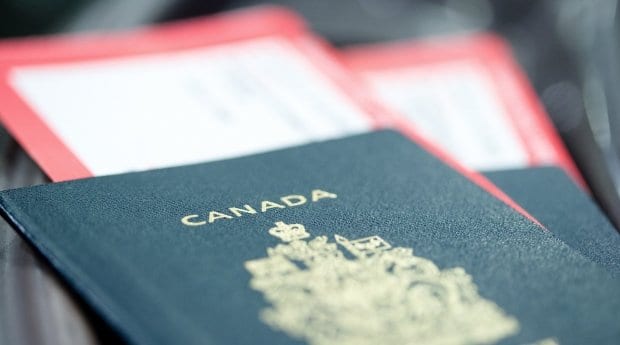Passport Canada has rejected the idea of sex-unspecified passports, despite reports in May 2012 that it was considering their introduction, Xtra has learned.
Passport Canada nixed the idea of adding a third sex option (“X” for “unspecified”) just weeks after the idea was proposed two years ago. I found this out when I tried to apply for my own sex-unspecified passport.
After learning in March that I might not be able to obtain any passport because of conflicting sex designations on my documentation, I sent Passport Canada a complaint and requested a neutral travel document. I had hoped the government would honour my genderqueer identity, given that I am both male and female, depending on the document.
I was wrong.
“The Canadian passport complies with standards set by the International Civil Aviation Organization (ICAO), an agency of the United Nations responsible for setting international standard for travel documents,” was the response I received from Allison Kealty, Passport Canada’s director of entitlement policy. “Please note that ‘sex’ is a mandatory field in the Canadian passport as per ICAO.”
I rebutted. “While the ICAO does list sex as a mandatory field, it allows ‘X’ for ‘unspecified’ to fill that field, as per ‘Machine Readable Travel Documents.’”
The next response came from the Passport Program Management and Strategic Initiatives department. Its director general, Jean-Pierre Lamarche, told me that “the Passport Program completed its policy review regarding the sex shown in the passport in May 2012 and will maintain its current policy. According to the Passport Program’s policy, the sex indicated on a passport must be identical to the sex inscribed on the applicant’s documentary evidence of citizenship.”
I phoned Lamarche to ask him to elaborate on his email for the sake of this article. He declined to speak to the media. However, a spokesperson for Citizenship and Immigration Canada told me that “Passport Program’s mandate is not to determine an individual’s identity . . . but rather to authenticate an identity with the aid of source documents.”
When asked whether issuing a passport with an “unspecified” designation constituted determining an individual’s identity, the agency said it had nothing further to add.
But the spokesperson did tell me the rationale behind Passport Canada’s refusal to issue sex-unspecified passports. “This requirement is intended to enhance the integrity of the Canadian passport issuance process and the integrity of the Canadian passports themselves, which in turn helps to prevent Canadians traveling abroad undergoing additional scrutiny at international borders crossings and airports, hostile treatment and arbitrary detention by foreign law enforcement.”
This rationale appears similar to the reasoning Passport Canada gave in a 2002 letter to a complainant who wished to change her passport from male to female without having sex-reassignment surgery. “To inscribe a person’s sex in a Canadian passport as one gender when the person is legally the other gender would be to knowingly falsify information,” says the letter, which I obtained through an access-to-information request.
“Should a foreign country be made aware that Canada will intentionally inscribe false information in passports, this could result in serious consequences for the international reputation of the Canadian passport,” the letter continues. “They may go as far as to not recognize Canadian passports or to refuse entry to any person carrying only a Canadian passport.”
“To imply that trans people who do not fit neatly into a gender binary are somehow committing a falsehood is a reprehensible way to describe the lived experiences of trans people,” says Adrienne Smith, a lawyer dealing with health and drug policy at Pivot Legal Society in Vancouver.
“They are making this argument in favour of protecting travellers from being held in hostile or arbitrary detention, but trans people experience this already just based on their sheer appearance when they present at these checkpoints,” adds Smith, who identifies as genderqueer and trans.
Michiko Bown-Kai, a genderqueer student in Toronto, believes having an “X” designation would be useful.
“For some people, because of how they’re read or because of their gender, it’s safer for them to show up at an airport and have someone look at their passport and them and not have any assumptions or confusions happen based on [their sex inscription],” says Bown-Kai, who uses the gender-neutral pronoun they.
Both Smith and Bown-Kai do, however, raise concerns about the safety of people carrying passports inscribed with the “X” gender option. The “X” option “singles them out and exposes them, and that can be profoundly dangerous for lots of people,” Smith says. “The only way to include people who don’t fit in a binary and to keep them safe is to have no sex markers on ID documents.”
Susan Gapka, chair of the Trans Lobby Group, also takes a critical look at sex designations that can “out” trans and intersex people.
“Having male or female on passports or any piece of identification is kind of becoming outdated,” Gapka says. “Because we have photo ID, we have a lot of ways to detect the person’s authenticity . . . so you really don’t need to list the gender on a passport.”
Still, Gapka believes that, for as long as there is such a requirement, a neutral option should be available for those who want it. Ultimately though, she advocates for the abolition of sex designations, stating “there is no reason to have a sex designation on identity documents.”
Canada isn’t in a position to unilaterally remove sex inscriptions from its passport, as “sex” is a mandatory field under ICAO regulations.
A 2011 Egale Canada report recommended Canada “take the position in relevant international fora that the inscription of sex on machine readable travel documents is unnecessary, and the requirement for its inclusion be removed from the ICAO Standards.”
The report, which was addressed to Allison Kealty and obtained by Xtra, contains many recommendations, including arguments in favour of sex-unspecified passports, which are already available in Australia, Bangladesh and New Zealand.
“A gender neutral option for sex inscriptions on the Canadian passport is generally supported by the trans and gender diverse community in Canada,” the report reads. “It is highly recommended that this option be enacted fully in Canada, opening up the option of ‘X,’ indicating unspecified, to all Canadians.”
The report equally recommends removing sex-reassignment surgery as a requirement to change one’s sex inscription within the existing sex designation options.
In order to change the sex designation, a spokesperson for Passport Canada says, applicants must submit “documentary evidence of citizenship showing the new sex, or documentary evidence of citizenship showing the former sex, accompanied by medical documentation.”
A limited validity passport, valid for only two years, may also be issued if the applicant submits proof that surgery will be undergone within 12 months.
In certain provinces, such as Ontario and British Columbia, trans Canadians can change the sex on their passports without proof of surgery (provided they’re willing to select one of the existing sex designations). To do so, they must amend the sex designation on their birth certificate with a doctor’s note attesting to their trans status and then apply for a new passport. This option isn’t available in other provinces, such as Saskatchewan and Nova Scotia, where proof of surgery remains a requirement.
Passport Canada is not the only government agency that imposes barriers on trans and intersex travellers in Canada. According to Transport Canada’s identity screening regulations, “an air carrier shall not transport a passenger if . . . the passenger does not appear to be of the gender indicated on the identification he or she presents.”
A spokesperson for Transport Canada told Xtra in 2012 that people who may be affected by the regulations would be permitted to fly if they provide medical certificates. The clause the spokesperson cited, however, refers to a mismatch between the photo and the person’s face, not between the sex inscription and the person’s perceived sex.
“I get little reassurance from this provision in the identity screening regulations that says it will be fine if you have a doctor’s letter with you,” Smith says. “This section has to do with a mismatch between photo ID and the person, so if you no longer match the image of yourself, there is a requirement that says you can have a doctor’s letter. But what I’m hearing from members of my community and from clients of mine is that, despite having a doctor’s letter, trans people are often grounded because their identity documents don’t match their current appearance.”
Between Passport Canada’s and Transport Canada’s rules, many trans and intersex Canadians who need or wish to travel are reluctant to do so.
“I’ve avoided going anywhere because of having to travel with my [female] passport,” says Lennox LePage, a trans man who sits on the board of directors of Pride Muskoka in Ontario. “I certainly wouldn’t attempt to fly with my passport for any reason.”
Alec Butler, an acclaimed artist who was born intersex and identifies as two-spirit, calls Passport Canada’s policy on sex-unspecified passports “ridiculous.”
“The prospect of travelling as gender non-binary was enough of a hassle to keep me from travelling to film festivals where my films were being screened for the last 15 years,” Butler says.
“Different bodies have different concerns around passing through airport security and [around] how body scans work,” Bown-Kai notes. “But I think that the problem is that there are bigger issues around [using] gender norms to ensure security.”
So when Passport Canada told me I’d be eligible only for a male passport, I got nervous. I am not usually read as male, and I didn’t want to miss my upcoming flight to Halifax. Given Transport Canada’s rules, I decided the less risky option would be to present as a woman and use my female driver’s licence for the domestic flight. Thankfully, the airline allowed me to board without issue.
With a male passport and some masculine effort, perhaps the result would have been the same. With an unspecified passport, I might not have had to worry.


 Why you can trust Xtra
Why you can trust Xtra


